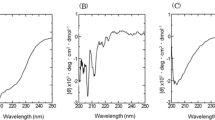Abstract
Heparin was immobilized on a polystyrene plate in a specificpattern by photolithography. Heparin was coupled with azidoaniline. Thederivatized heparin was cast on the polystyrene plate from aqueoussolution. After drying, the plate was photo-irradiated in the presence of aphotomask. The micropatterning was confirmed by staining with a dye,ethydium bromide. Since heparin has negative charges, the cationic dyewas adsorbed on the regions where heparin was immobilized. In thepresence fibroblast growth factor (FGF), the growth of mouse fibroblastSTO cells was enhanced only on the heparin-immobilized regions. Thisresult indicated that micropattern-immobilized heparin activated FGF forcell growth activity.
Similar content being viewed by others
References
Casu B (1995) Structure and biological activity of heparin. Adv Carb Chem Biochem 43: 51–134.
Chen G, Ito Y and Imanishi Y (1997) Photo-immobilization of epidermal growth factor enhances its mitogenic effect by artificial juxtacrine signalling. Biochem Biophys Acta 1358: 200–208.
Chen G, Ito Y, Imanishi Y, Magnani A, Lamponi S and Barbucci R (1998) Photoimmobilization of sulphated hyaluronic acid for antithrombogenicity. Bioconjug Chem 8: 730–734.
Digrabriele AD, Lax I, Chen DI, Svahan CM, Jaye M, Schlessinger J and Hendrickson WA (1998) Structure of a heparin-linked biologically active dimer of fibroblast growth factor. Nature 393: 812–817.
Faham S, Hileman RE, Fromm JR, Linhardt RJ and Rees DC (1996) Heparin structure and interactions with basic fibroblast growth factor. Science 272: 1116–1120.
Ito Y (1987) Antithrombogenic heparin-bound polyurethanes. J Biomater Appl 2: 235–265.
Ito Y (1998) Tissue engineering by immobilized growth factor. Mater Sci Eng C6: 267–274.
Ito Y, Liu SQ and Imanishi Y (1991) Enhancement of cell growth on growth-factor-immobilized polymer film. Biomaterials 12: 449–453.
Ito Y, Zheng J, Imanishi Y, Yonezawa K and Kasuga M (1996) A protein-free cell culture on an artificial substrata covalently immobilized with insulin. Proc Natl Acad Sci USA 93: 3598–3601.
Ito Y, Chen G, Guan G and Imanishi Y (1997a) Patterned immobilization of thermo-responsive polymer. Langmuir 13: 2756–2759.
Ito Y, Kondo S, Chen G and Imanishi Y (1997b) Patterned artificial juxtacrine stimulation of cells by covalently immobilized insulin. FEBS Lett 403: 159–162.
Ito Y, Li J-S, Takahashi T, Imanishi Y, Okabayashi Y, Kido Y and Kasuga M (1997c) Enhancement of the mitogenic effect by artificial juxtacrine stimulation using immobilized EGF. J Biochem 121: 514–520.
Ito Y, Chen G and Imanishi Y (1998a) Micropatterned immobilization of epidermal growth factor to regulate cell function. Bioconjug Chem 9: 277–282.
Ito Y, Chen G and Imanishi Y (1998b) Artificial juxtacrine stimulation for tissue engineering. J Biomat Sci Polym Edn 9: 879–890.
Matsuda T and Sugawara T (1995a) Development of a novel protein fixation method with micron-order precision. Langmuir 11: 2267–2271.
Matsuda T and Sugawara T (1995b) Photochemical protein fixation on polymer surfaces via derivatized phenyl azido group. Langmuir 11: 2272–2276.
Ornitz DM, Yayon A, Flanagan JG, Svahn CM, Levi E and Leder P (1992) Heparin is required for cell-free binding of basic fibroblast growth factor to a soluble receptor and for mitogenesis in whole cells. Mol Cell Biol 12: 240–247.
Author information
Authors and Affiliations
Rights and permissions
About this article
Cite this article
Park, Y.S., Ito, Y. Micropattern-immobilization of heparin to regulate cell growth with fibroblast growth factor. Cytotechnology 33, 117–122 (2000). https://doi.org/10.1023/A:1008154326954
Issue Date:
DOI: https://doi.org/10.1023/A:1008154326954




